
1613 (MDCXIII) was a common year starting on Tuesday of the Gregorian calendar and a common year starting on Friday of the Julian calendar, the 1613th year of the Common Era (CE) and Anno Domini (AD) designations, the 613th year of the 2nd millennium, the 13th year of the 17th century, and the 4th year of the 1610s decade. As of the start of 1613, the Gregorian calendar was 10 days ahead of the Julian calendar, which remained in localized use until 1923.

Lacquer is a type of hard and usually shiny coating or finish applied to materials such as wood or metal. It is most often made from resin extracted from trees and waxes and has been in use since antiquity.

Claydon House is a country house in the Aylesbury Vale, Buckinghamshire, England, near the village of Middle Claydon. It was built between 1757 and 1771 and is now owned by the National Trust.

Lacquerware are objects decoratively covered with lacquer. Lacquerware includes small or large containers, tableware, a variety of small objects carried by people, and larger objects such as furniture and even coffins painted with lacquer. Before lacquering, the surface is sometimes painted with pictures, inlaid with shell and other materials, or carved. The lacquer can be dusted with gold or silver and given further decorative treatments.

Chinoiserie is the European interpretation and imitation of Chinese and other East Asian artistic traditions, especially in the decorative arts, garden design, architecture, literature, theatre, and music. The aesthetic of chinoiserie has been expressed in different ways depending on the region. It is related to the broader current of Orientalism, which studied Far East cultures from a historical, philological, anthropological, philosophical, and religious point of view. First appearing in the 17th century, this trend was popularized in the 18th century due to the rise in trade with China and the rest of East Asia.

Japanning is a type of finish that originated as a European imitation of East Asian lacquerwork. It was first used on furniture, but was later much used on small items in metal. The word originated in the 17th century. American work, with the exception of the carriage and early automobile industries, is more often called toleware.

Sir Edmund Verney was an English politician, soldier and favourite of King Charles I. At the outbreak of the English Civil War he supported the Royalist cause and was killed at the Battle of Edgehill.

The Verney family purchased the manor of Middle Claydon in Buckinghamshire, England, in the 1460s and still resides there today at the manor house known as Claydon House. This family had been seated previously at Fleetmarston in Buckinghamshire then at Pendley in Hertfordshire. It is not to be confused with the unrelated but also ancient and prominent Verney family of Compton Verney in Warwickshire.

Earl Verney, in the Province of Leinster, was a title in the Peerage of Ireland. Sir Ralph Verney sat as a member of parliament for Aylesbury, for Great Bedwyn and for Buckingham. In 1661 he was created a Baronet, of Middle Claydon in the County of Buckingham, in the Baronetage of England. His son Sir John Verney, Bt, was a member of parliament for Buckinghamshire and for Amersham. In 1703, he was raised to the Peerage of Ireland as Baron Verney of Belturbet, in the County of Cavan, and Viscount Fermanagh. His son, the second Viscount, represented Amersham and Wendover in Parliament. In 1742 he was created Earl Verney, in the Province of Leinster, in the Peerage of Ireland. However, all titles became extinct on the death of his son, the second Earl, in 1791.

Sir Hugh Acland, 5th Baronet was an English Member of Parliament, from a family of Devonshire gentry. He obtained a confirmation of the family baronetcy in 1678, and served as a Member of Parliament for two boroughs in Devon in 1679 and from 1685 to 1687. Never very active in national politics, he was one of the many Tories estranged by James II's pro-Catholicism, but remained a Tory after the Glorious Revolution. He continued to hold local office in Devon off and on until his death in 1714, when he was succeeded by his grandson.

Sir Ralph Verney, 1st Baronet DL, JP was an English baronet and politician who sat in the House of Commons at various times between 1640 and 1690.

John Verney, 1st Viscount Fermanagh, known as Sir John Verney, 2nd Baronet, between 1696 and 1703, was an English peer, merchant and Tory politician who sat in the House of Commons from 1710 to 1717.

Lacquerware is a Japanese craft with a wide range of fine and decorative arts, as lacquer has been used in urushi-e, prints, and on a wide variety of objects from Buddha statues to bento boxes for food.
Sir Ralph Assheton, 2nd Baronet of Middleton Hall and Whalley Abbey, Lancashire, was an English landowner and politician who represented Liverpool (1677–79) and Lancashire (1694–98) as a Member of Parliament.

Sir William Courtenay, 1st Baronet was an English politician.
John Evelyn the younger (1655–1699) was an English translator.

William Stanton (1639–1705) was an English mason and sculptor. He is known particularly for monumental masonry. He is often ferred to as Stanton of Holborn.

Mary Verney was the wife of Sir Ralph Verney, 1st Baronet, of Middle Claydon DL, JP (1613–1696), an English baronet and politician who sat in the House of Commons.

Sir Edward Phelips Jr. esq of Montacute was an English landowner and politician who sat in the House of Commons at various times between 1661 and 1699.

















